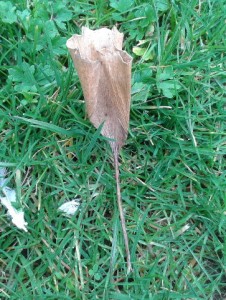This week, while collecting samples of Ginkgo leaves from the tree behind Whiteknights House, I noticed that the remaining leaves seemed to be caught upright in the lengthening grass.
I assumed to start with that the leaves were being held in place by the grass but closer inspection showed that this was not the case.
The petioles (or stalks) of the leaves were actually within the soil as if they’d been pushed vertically in. ??? One leaf had its entire 5 cm of petiole within the soil!
Ginkgo leaves decay very slowly because they are full of fungicides. Decay doesn’t seem to start until the leaves are first physically damaged e.g. by lawn mowing. I would guess that this physical break-up of the leaves allows the fungicides to leach out so that normal fungal decay can begin. In the absence of lawn mowers, or gardeners with rakes and bonfires, how are Ginkgo leaves recycled?
And how do the petioles of the leaves end up pushed? or pulled? down into the soil? The only theory I have is earthworms. The leaves are certainly a weird sight!





Your observation reminds me of a passage in Darwin’s book on worms where he describes how, amongst other things, earthworms pull leaves down into their burrows narrow end foremost.